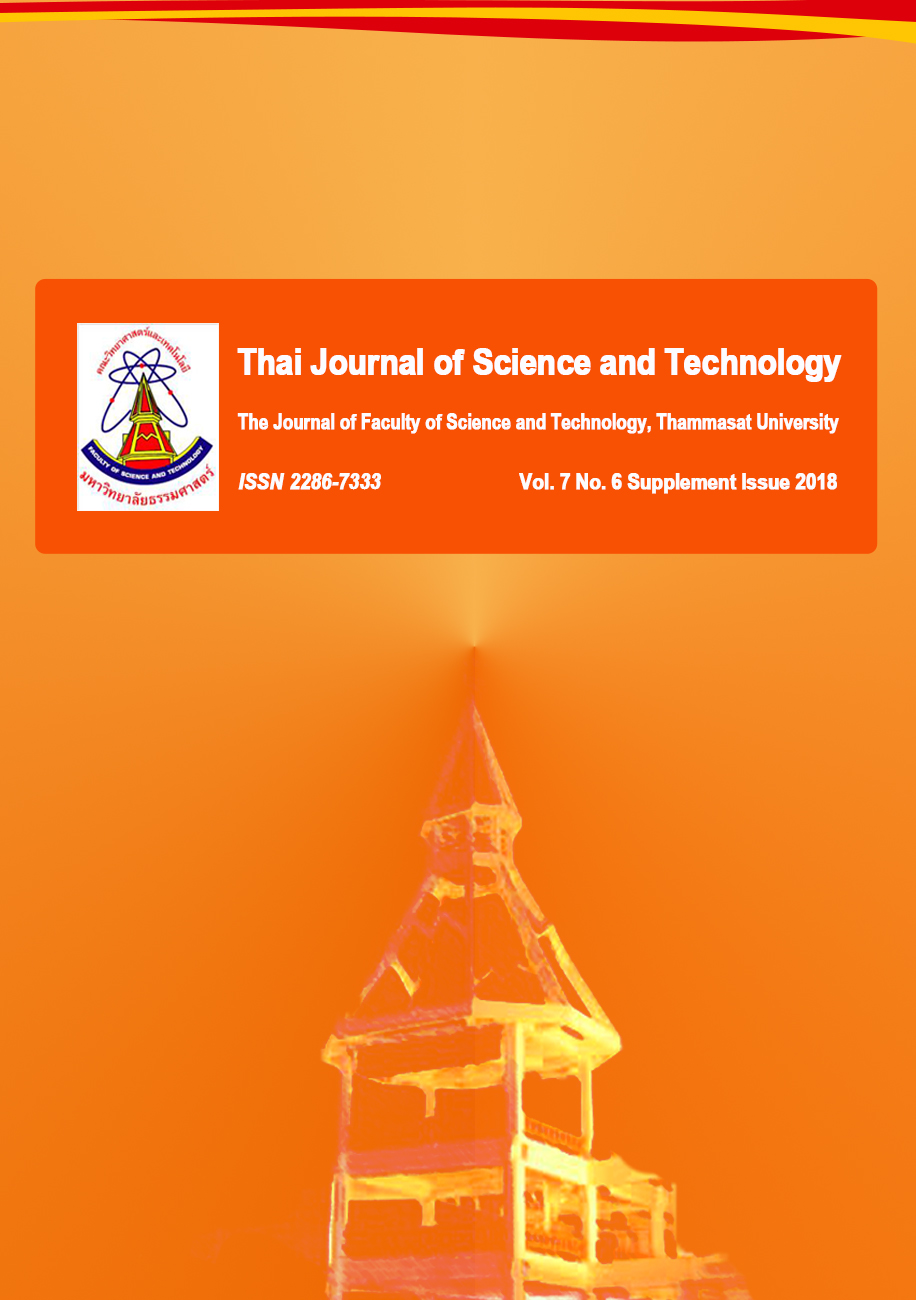เฮลิโคแบคเตอร์ ไพโลไร รูปร่างทรงกลม ซึ่งมีชีวิต แต่ไม่เจริญเติบโต ยังคงสร้างกลูตามิลทรานส์เพปทิเดสที่เป็นปัจจัยก่อความรุนแรงโรค
Main Article Content
บทคัดย่อ
บทคัดย่อ
Helicobacter pylori ในสภาวะปกติมีรูปร่างแบบเกลียว (spiral) แต่ในสภาวะที่ได้รับความเครียดจะปรับตัวให้อยู่ในรูปร่างทรงกลม (coccoid) เพื่อให้สามารถดำรงชีวิตอยู่ได้ แต่จะไม่เจริญเติบโต (viable but non-culturable, VBNC) การศึกษาก่อนหน้านี้รายงานว่าแบคทีเรียระยะ VBNC ยังมีการสร้าง mRNA ของ virulence factors บางชนิดอยู่ จากการที่เอนไซม์ g-glutamyl transpeptidase (GGT) ซึ่งเป็นเอนไซม์ที่เกี่ยวข้องกับการ colonization ของ H. pylori ยังไม่เคยมีการศึกษาเมื่อแบคทีเรียอยู่ในรูปร่าง coccoid มาก่อน การศึกษานี้จึงมีวัตถุประสงค์เพื่อวิเคราะห์การแสดงออกของยีน ggt ของ H. pylori ในสภาพ coccoid โดยการทำให้ H. pylori ที่มีรูปร่างเป็น spiral ซึ่งต้องการออกซิเจนเพียงเล็กน้อยเปลี่ยนไปเป็นรูปร่าง coccoid โดยการเลี้ยงในสภาวะที่มีออกซิเจนบรรยากาศในช่วงระยะเวลาหนึ่ง และศึกษาเปรียบเทียบการถอดรหัสของยีน ggt ระหว่างแบคทีเรียรูปร่าง coccoid และรูปร่าง spiral จากการทดลองพบว่าหลังจากแบคทีเรียได้สัมผัสออกซิเจนบรรยากาศนาน 9 ชั่วโมง แบคทีเรียจะเปลี่ยนไปเป็นรูปร่าง coccoid อย่างสมบูรณ์ และยังคงมีการสร้าง mRNA ของยีน ggt อย่างต่อเนื่อง แสดงว่าแม้ H. pylori จะอยู่ในระยะ VBNC ก็ยังสามารถสร้าง virulence factor ที่เกี่ยวข้องกับการ colonization ได้ เหตุการณ์ดังกล่าวสามารถเกิดขึ้นได้ในชีวิตประจำวัน เมื่อ H. pylori เกิดการปนเปื้อนในสิ่งแวดล้อมโดยไม่ได้ตั้งใจ และนำไปสู่การติดเชื้อที่ไม่สามารถควบคุมได้
คำสำคัญ : เฮลิโคแบคเตอร์ ไพโลไร; กลูตามิลทรานส์เพปทิเดส; แบคทีเรียรูปทรงกลม
Article Details
บทความที่ได้รับการตีพิมพ์เป็นลิขสิทธิ์ของคณะวิทยาศาสตร์และเทคโนโลยี มหาวิทยาลัยธรรมศาสตร์ ข้อความที่ปรากฏในแต่ละเรื่องของวารสารเล่มนี้เป็นเพียงความเห็นส่วนตัวของผู้เขียน ไม่มีความเกี่ยวข้องกับคณะวิทยาศาสตร์และเทคโนโลยี หรือคณาจารย์ท่านอื่นในมหาวิทยาลัยธรรมศาสตร์ ผู้เขียนต้องยืนยันว่าความรับผิดชอบต่อทุกข้อความที่นำเสนอไว้ในบทความของตน หากมีข้อผิดพลาดหรือความไม่ถูกต้องใด ๆ
References
Chevalier, C., Thiberge, J., Ferrero, R.L. and Labigne, A., 1999, Essential role of Helicobacter pylori γ-glutamyl transpeptidase for the colonization of the gastric mucosa of mice, Mol. Microbiol. 31: 1359-1372.
Chomczynski, P. and Sacchi, N., 1987, Single step method of RNA isolation by acid guanidinium thiocyanate-phenol-chloroform extraction, Anal. Biochem. 162: 156-159.
Cover, T.L., 2016, Helicobacter pylori diversity and gastric cancer risk, MBio 7(1): e01869-15.
Donelli, G., Matarrese, P., Fiorentini, C., Dainelli, B., Taraborelli, T., Campli, E., Bartolomeo, S. and Cellini, L., 1998, The effect of oxygen on the growth and cell morphology of Helicobacter pylori, FEMS Microbiol. Lett. 168: 9-15.
Leduc, D., Gallaud, J., Stingl, K. and de Reuse, H., 2010, Coupled amino acid deamidase-transport systems essential for Helicobacter pylori colonization, Infect Immun. 78: 2782-2792.
Monstein, H.J. and Jonasson, J., 2001, Differen-tial virulence-gene mRNA expression in coccoid forms of Helicobacter pylori, Biochem. Biophys. Res. Commun. 285: 530-536.
Nilsson, H.O., Blom, J., Al-Soud, W.A., Ljungh, A., Andersen, L.P. and Wadstrom, T., 2002, Effect of cold starvation, acid stress, and nutrients on metabolic activity of Helicobacter pylori, Appl. Environ. Microbiol. 68: 11-19.
Obonyo, M., Zhang, L., Thamphiwatana, S., Pornpattananangkul, D., Fu, V. and Zhang, L., 2012, Antibacterial activities of liposomal linolenic acids against antibiotic-resistant Helicobacter pylori, Mol. Pharm. 9: 2677-2685.
Pfaffl, M.W., 2001, A new mathematical model for relative quantification in real-time RT-PCR, Nucl. Acids Res. 29: e45.
Poursina, F., Faghri, J., Moghim, S., Zarkesh-Esfahani, H., Nasr-Esfahani, B., Fazeli, H., Hasanzadeh, A.V. and Safaei, H.G., 2013, Assessment of cagE and babA mRNA expression during morphological conversion of Helicobacter pylori from spiral to coccoid, Curr. Microbiol. 66: 406-413.
Shao, C., Sun, Y., Wang, N., Yu, H., Zhou, Y., Chen, C. and Jia, J., 2013, Changes of proteome components of Helicobacter pylori biofilms induced by serum starvation, Mol. Med. Rep. 8: 1761-1766.
She, F.F., Lin, J.Y., Liu, J.Y., Huang, C. and Su, D.H., 2003, Virulence of water-induced coccoid Helicobacter pylori and its experimental infection in mice, World J. Gastroenterol. 9: 516-520.
Shibayama, K., Wachino, J., Arakawa, Y., Saidijam, M., Rutherford, N.G. and Henderson, P.J., 2007, Metabolism of glutamine and glutathione via gamma-glutamyltranspeptidase and glutamate transport in Helicobacter pylori: Possible significance in the pathophysiology of the organism, Mol. Microbiol. 64: 396-406.
Sisto, F., Brenciaglia, M.I., Scaltrito, M.M. and Dubini, F., 2000, Helicobacter pylori: ureA, cagA and vacA expression during conversion to the coccoid form, Int. J. Antimicrob. Agents 15: 277-282.
Stark, R.M., Suleiman, M.S., Hassan, I.J., Greenman, J. and Millar, M.R., 1997, Amino acid utilization and deamination of glutamine and asparagine by Helicobacter pylori, J. Med. Microbiol. 46: 793-800.
Roger-Broadway, K.R. and Karteris, E., 2015, Amplification efficiency and thermal stability of qPCR instrumentation: Current landscape and future perspectives, Exp. Ther. Med. 10: 1261-1264.
Romano, M., Ricci, V. and Zarrilli, R., 2006, Mechanisms of disease: Helicobacter pylori-related gastric carcinogenesis implications for chemoprevention, Nat. Clin. Pract. Gastroenterol. Hepatol. 3: 622-632.
Tominaga, K., Hamasaki, N., Watanabe, T., Uchida, T., Fujiwara, Y., Takaishi, O., Higuchi, K., Arakawa, T., Ishii, E., Kobayashi, K., Yano, I. and Kuroki, T., 1999, Effect of culture conditions on morphological changes of Helicobacter pylori, J. Gastroenterol. 11: 28-31.
Zeng, H., Guo, G., Mao, X.H., Tong, W.D. and Zou, Q.M., 2008, Proteomic insights into Helicobacter pylori coccoid forms under oxidative stress, Curr. Microbiol. 57: 281-286.

